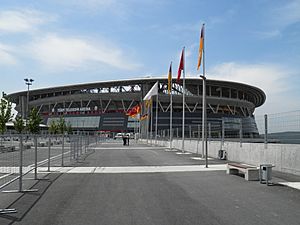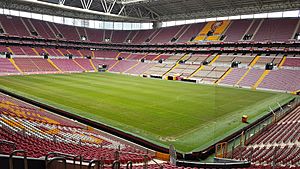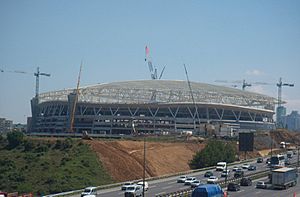Rams Park facts for kids
|
Ali Sami Yen
Aslantepe |
|

|
|
| Full name | Rams Park |
|---|---|
| Former names |
List
Türk Telekom Arena (2011–2017)
Türk Telekom Stadium (2017–2021) Nef Stadium (2021–2023) |
| Location | Sarıyer, Istanbul, Turkey |
| Coordinates | 41°6′10″N 28°59′26″E / 41.10278°N 28.99056°E |
| Public transit | |
| Owner | Galatasaray |
| Operator | Galatasaray |
| Executive suites | 221 |
| Capacity | 53,978
Capacity history
52,695 (2011–2013)
52,280 (2013–2023) 53,978 (2023–) |
| Record attendance | 53,755 (Fenerbahçe, 19 May 2024) |
| Field size | 105 m × 68 m (115 yd × 74 yd) |
| Acreage | 190,000 m² |
| Surface | Grass (2011–2018) SISGrass |
| Scoreboard | 2 x 77,41m² |
| Construction | |
| Broke ground | 13 December 2007 |
| Built | 2007–2011 |
| Opened | 15 January 2011 |
| Construction cost | US$250 million ($325 million in 2022 dollars ) |
| Architect | 'asp' architekten Stuttgart |
| Structural engineer | İz Mühendislik Yüksel Proje Schlaich Bergermann & Partner |
| Services engineer | OBERMEYER: Planungsgesellschaft |
| Main contractors | Varyap
Uzunlar Ortak Girişimi TOKİ |
| Tenants | |
| Galatasaray (2011–present) Turkey national football team (selected matches) |
|
Rams Park is a super cool football stadium in Istanbul, Turkey. It's the home ground for the famous football club Galatasaray. The stadium is also known as Ali Sami Yen Spor Kompleksi.
This stadium is located in the Seyrantepe area of Sarıyer district. It can hold 53,978 fans, making it a huge place for exciting football games! Rams Park is part of a bigger sports area named after Ali Sami Yen, who founded the Galatasaray club.
Rams Park was the first stadium in Turkey to meet the high standards for the UEFA Euro 2016 tournament. In 2011, it was even nominated for "Venue of the Year" and "New Venue" awards. Galatasaray won the Süper Lig title in their very first season playing here.
The stadium is also considered for hosting games in the UEFA Euro 2032 tournament. In 2025, Rams Park was ranked as the second most environmentally friendly stadium in the world by the World Economic Forum.
Contents
Stadium History
Football started in Istanbul with British players on a field called Papazın Çayırı. Later, the Taksim Stadium became the main football spot in 1921. But this stadium was torn down in 1940. Other clubs found new homes, but Galatasaray had trouble finding a permanent place.
In the 1930s, Galatasaray tried to get land in Mecidiyeköy for a stadium. They started digging in 1936, but the project stopped. In 1940, Galatasaray leased the same land for 30 years for a tiny fee. They planned a modern stadium, but World War II made it hard to get money.
A small stadium with an open stand was built in 1945. But it was far from the city and hard to reach, so not many games were played there. When the İnönü Stadium opened in the city center, Galatasaray stopped working on the Mecidiyeköy stadium.
In 1959, construction started again, and in 1961, Galatasaray officially got the rights to use the new stadium. It opened on December 20, 1964, but it was so crowded that one person died and 80 were hurt. The stadium got lights in 1965, but night games were still rare.
In the 1970s, the stadium was mostly used for training and was not well-maintained. In 1981, grass was planted, and the stadium reopened. The lights were updated in 1993, allowing night games. Seats replaced old benches, reducing the capacity from 35,000 to 22,000.
On December 10, 2013, a UEFA Champions League match between Galatasaray and Juventus had to stop because of heavy snow. The game finished the next day.
New Stadium Plans
Galatasaray wanted a new, modern stadium. Several plans were made over the years.
- In 1998, a plan for a 40,484-seat stadium was proposed, but it wasn't approved.
- In 2001, a smaller, cheaper plan for 35,000 seats was made, but money problems stopped it.
- After some renovations, Galatasaray returned to the old Ali Sami Yen Stadium in 2004.
- Because Mecidiyeköy became a busy city center, the government didn't want the stadium to expand there. They offered Galatasaray new land.
A Dream Comes True
Finally, in 2007, a deal was made to build a new stadium in Aslantepe. The old stadium land in Mecidiyeköy was exchanged for the new land.
The groundbreaking ceremony for the new stadium happened on December 13, 2007. A new design was chosen. Construction sped up in 2009. The new stadium, Rams Park, officially opened on January 15, 2011.
Stadium Projects Overview
Here's a quick look at the main stadium projects:
| Project | Year | Location | Capacity | Architect | Cost | Info |
|---|---|---|---|---|---|---|
| Faruk Süren project | 1997–2001 | Mecidiyeköy | 40,482 | BBB Architects | US$118.5 million | Planned a mall next to the stadium |
| Mehmet Cansun project | 2001 | Mecidiyeköy | 35,000 | GS member Architecture group | US$35 million | A cheaper version of the plan |
| Özhan Canaydın:Back to Süren's project | 2002–2005 | Mecidiyeköy | 40,482 | BBB Architects | US$90 million | Same project, lower cost |
| Eren Talu bidding project | 2007 | Aslantepe | 52,000 | Populous | n/a | GS logo as a ramp design |
| Özhan Canaydın project | 2007 | Aslantepe | 52,652 | asp Stuttgart | US$250 million | This is the stadium that was built! |
Aslantepe: The New Home
Since the old stadium couldn't be made bigger, Galatasaray needed a new place. The new stadium was built near the Maslak financial district. The area's old name, Seyrantepe, was changed to Aslantepe (Lion Hill) because "Aslan" (Lion) is Galatasaray's symbol.
The stadium was designed to be like the Arena AufSchalke in Germany. It has a special retractable roof, which was the first of its kind in Turkey.
Building the Stadium
Galatasaray worked with TOKİ, a big Turkish construction organization. The Eren Talu Architecture – ALKE Partnership won the bid to build the stadium. The contract was signed on October 23, 2007.
The project was called the "Aslantepe Tender." It included building a multi-purpose sports complex with 52,652 seats. In exchange, Galatasaray's old stadium land in Mecidiyeköy was used for other city projects.
The construction was planned to take 720 days. The stadium has 198 special suites, VIP lounges, a VIP market, a food court, the Galatasaray Museum, and several Galatasaray Stores. It has five upper levels and four underground levels.
The Eren Talu-ALKE team partnered with the Abu Dhabi Group and Al Zarooni Group from the UAE. These groups invested a total of $650 million in the stadium and the Mecidiyeköy projects. The stadium construction cost about US$191 million, plus more for improving the surrounding area.
Construction stopped twice due to financial issues. Eventually, the Varyap-Uzunlar group took over, and building restarted in September 2009. The stadium opened without its retractable roof, which was added later.
Groundbreaking Ceremony
The official construction began on December 13, 2007, with a big ceremony. Many important people, including club officials and government ministers, attended. The club president, Özhan Canaydın, said the new complex would be a great addition to Turkish sports and a symbol of its progress.
Stadium Names
Türk Telekom Sponsorship
The stadium's naming rights were sold to Türk Telekom for 10 years. It was officially called Türk Telekom Arena from 2011. Other parts of the stadium also had sponsors. For example, Pegasus Airlines sponsored the North tribune, and Ülker sponsored the first tier of the East tribune. Denizbank sponsored the suites and VIP seats. Later, Opel and Odeabank also became sponsors for different stands.
NEF Sponsorship
On October 11, 2021, Galatasaray announced a new sponsorship deal with the real estate company NEF. The stadium was then called Ali Sami Yen Sports Complex Nef Stadium. This was a very large sponsorship deal in Turkish sports history.
Rams Global Sponsorship
On July 21, 2023, Rams Global became the new main sponsor. The stadium is now known as Rams Park.
Individual Stand Sponsorships
| Stand | Sponsor | Duration | € M/year | Total € M |
|---|---|---|---|---|
| Stadium | Türk Telekom | 10 years (2011–2021) | 7.5 | 75 |
| Nef | 2 years (2021–2023) | 7.9 | 15.8 | |
| Rams Global | 5 years (2023–2028) | 8.7 | 43,5 | |
| North | Pegasus Airlines | 2 years (2011–2013) | 4 | 8 |
| Odeabank | 5 years (2013–2018) | 0.59 | 2.95 | |
| South | Opel | 2.5 years (2012–2015) | 1.5 | 3.75 |
| MNG Kargo | 2 years (2015–2017) | ? | ? | |
| 1st tier East | Ülker | 2 years (2011–2013) | 2 | 4 |
Cool Facts About Rams Park

Size and Capacity
- The stadium building covers 195,000 square meters.
- The actual playing field is 105 meters by 68 meters.
- The stadium has 53,978 seats for fans.
- There are 221 special suites, which are like private boxes, with 6,321 seats. Each suite can hold 6 to 27 people.
Construction Details
- Builders used 190,000 cubic meters of concrete.
- They also used 35,000 tonnes of steel for the stadium.
- The roof alone needed 5,500 tonnes of steel.
Recent Upgrades
2018: Hybrid Grass
In January 2018, a new type of grass called SISGrass was installed. This hybrid grass mixes natural grass with artificial fibers, making the pitch stronger and better for playing.
2022: Solar Panels
In 2021, Galatasaray and Enerjisa planned to put solar panels on the stadium's roof. The goal was for the stadium to make its own energy.
By 2022, 10,404 solar panels were installed on the roof, covering 16,700 square meters. These panels are expected to provide 63% of the stadium's energy needs. This project helped Rams Park earn a Guinness World Records title for being the "Most Powerful Stadium Operated by Solar Energy."
2023: More Suites and Seats
In the summer of 2023, the stadium added 23 new suites, bringing the total to 221. Also, new rows of seats were added to the East and West stands, increasing the total capacity from 52,280 to 53,978.
2025: LED Screen and Light Upgrade
Between May and August 2025, Rams Park got a big upgrade. The main video screens were made larger, and the stadium's lights, both inside and out, were improved. New, high-resolution LED advertising boards were also installed around the stadium to make the matchday experience even better.
Concerts at Rams Park

Rams Park isn't just for football; it can also host huge concerts for over 70,000 people!
- The first band to play here was Bon Jovi on July 8, 2011.
- The famous singer Madonna performed on June 7, 2012, as part of her MDNA Tour. She played for 47,789 fans.
Around the Stadium
Aslanlı Yol
When visitors arrive from the Seyrantepe Metro Station, they walk along a special path called Aslanlı Yol (Lion Road). This 200-meter-long, 45-meter-wide road helps guide fans to the stadium entrance. You can also find ticket sales, a Simit Sarayı Restaurant, and a Yüzevler Restaurant here.
Aslantepe GSStore
A new Galatasaray Store opened next to the stadium on February 7, 2012. It's a large store with two floors, covering 1,650 square meters. The first floor sells merchandise, and the second floor has the Ülker Fan Zone.
Getting There
Public Transport
Rams Park is easy to reach by public transport. Many bus routes go there, and the Metro M2 has a shuttle line from Sanayi Mahallesi Station to Seyrantepe, right at the stadium.
| Service/Operator | Station/Wharf | Line |
|---|---|---|
| Train |
Seyrantepe Metro station |
|
| Funicular |
Seyrantepe Metro station |
Car
The stadium is right next to the Otoyol 2 motorway. There are four parking garages with 3,225 parking spots, mostly covered. There are also 28 spots for buses at the west entrance.
Payment Methods
GS Bonus Card
The GS Bonus Card is Galatasaray S.K.'s stadium card. It can also be used as a credit card. Season tickets use special RFID cards. You can use this card for all services at the stadium.
fastPay
Since March 12, 2019, Galatasaray and DenizBank have allowed fans to pay with fastPay. This is Turkey's first digital wallet. Fans can use fastPay to shop at the stadium, stores, snack bars, and the GS Store without needing cash.
Stadium Records
Attendance Records
- The most people ever at Rams Park was 53,775. This happened during a Süper Lig match between Galatasaray and Fenerbahçe on May 19, 2024.
- For a UEFA Champions League match, the highest attendance was 51,792, when Galatasaray played FC Bayern Münich on October 24, 2023.
- A UEFA Europa League match between Galatasaray and Tottenham Hotspur on November 7, 2024, had 51,739 fans.
- A friendly game between Galatasaray and Ajax on January 15, 2011, had 40,000 people.
- For a Turkish Cup match, 31,930 fans watched Galatasaray play Gaziantepspor on March 2, 2011.
- The Turkish national team played Germany on October 7, 2011, with 49,532 fans.
- The highest attendance for a concert was 47,789 for Madonna's MDNA Tour on June 7, 2012.
Loudest Crowd
On March 18, 2011, Rams Park set a Guinness World Records record for the "loudest crowd roar at a sport stadium" at 131.76 decibels. However, this record has since been broken by several NFL American football games.
Matches Played Here
Turkey National Team Matches
Rams Park is one of the main stadiums where the Turkey national team plays its home games.
| Date | Time (CEST) | Team #1 | Result | Team #2 | Round | Attendance |
|---|---|---|---|---|---|---|
| 10 August 2011 | 20.30 | 3–0 | Friendly | 25,000 | ||
| 2 September 2011 | 19.00 | 2–1 | Euro 2012 qualifying | 47,756 | ||
| 7 October 2011 | 20.30 | 1–3 | Euro 2012 qualifying | 49,532 | ||
| 11 October 2011 | 19.00 | 1–0 | Euro 2012 qualifying | 32,174 | ||
| 11 November 2011 | 20.05 | 0–3 | Euro 2012 qualifying | 42,863 | ||
| 14 November 2012 | 20.30 | 1–1 | Friendly | 30,000 | ||
| 17 November 2014 | 20.45 | 3–1 | Euro 2016 qualifying | 27,549 | ||
| 14 November 2019 | 18.00 | 0–0 | Euro 2020 qualifying | 48,329 | ||
| 20 March 2025 | 18.00 | 3–1 | 2024–25 UEFA Nations League promotion/relegation play-offs | 38,500 |
2013 FIFA U-20 World Cup
The stadium was one of the places that hosted games for the 2013 FIFA U-20 World Cup. During this tournament, it was called Ali Sami Yen Arena because of sponsorship rules.
Here are some of the games played at the stadium during the 2013 World Cup:
| Date | Time (CEST) | Team #1 | Res. | Team #2 | Round | Attendance |
|---|---|---|---|---|---|---|
| 21 June 2013 | 18.00 | 3–1 | Group A | 4,133 | ||
| 21 June 2013 | 21.00 | 1–4 | Group A | 4,133 | ||
| 24 June 2013 | 18.00 | 1–1 | Group A | 4,120 | ||
| 24 June 2013 | 21.00 | 1–0 | Group A | 4,120 | ||
| 27 June 2013 | 20.00 | 2–1 | Group A | 7,511 | ||
| 27 June 2013 | 17.00 | 0–1 | Group B | 7,511 | ||
| 2 July 2013 | 18.00 | 2–1 | Round of 16 | 7,211 | ||
| 2 July 2013 | 21.00 | 1–2 | Round of 16 | 7,211 | ||
| 7 July 2013 | 21.00 | 4–3 | Quarterfinals | 6,632 | ||
| 13 July 2013 | 18.00 | 3–0 | Third place match | 20,601 | ||
| 13 July 2013 | 21.00 | 0–0 | Final | 20,601 |
Season Tickets and Attendance
| Season | Sold season tickets | Average league attendance |
|---|---|---|
| 2011 (just 2nd half) | 20,000 | 29,887 |
| 2011–2012 | 27,900 | 34,685 |
| 2012–2013 | 47,200 | 43,262 |
| 2013–2014 | 46,250* | 40,094 |
| 2014–2015 | 43,108 | 26,193 |
| 2015–2016 | 39,849 | 18,996 |
| 2016–2017 | 22,167 | 21,751 |
| 2017–2018 | 41,167 | 41,076 |
| 2018–2019 | 46,716 | 36,439 |
| 2019–2020 | 47,729 | 35,231 |
| 2020–2021 | N/A due to COVID-19 pandemic | |
| 2021–2022 | N/A due to COVID-19 pandemic | 21,425 |
| 2022–2023 | 40,105 | 45,516 |
| 2023–2024 | 42,000** | 43,251 |
| 2024–2025 | 41,614 | 44,525 |
| 2025–2026 | 42,000 | 45,816 (after one match) |
*Stopped at 46,250. Demand was 65,000. **Stopped at 42,000. Demand was 67,000.
Images for kids
See also
 In Spanish: Nef Stadium para niños
In Spanish: Nef Stadium para niños
- List of football stadiums in Turkey
- Istanbul bid for the 2020 Summer Olympics
- Lists of stadiums
- UEFA Euro 2032























